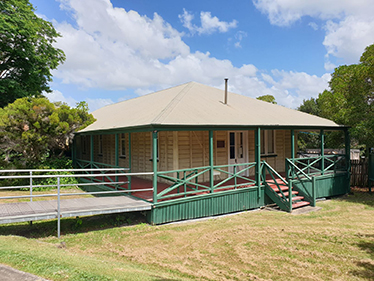Former Dunwich Benevolent Asylum Ward is heritage listed

The last surviving inmate accommodation of the former Dunwich Benevolent Asylum, known as Ward 13, has been entered into the Queensland Heritage Register.
“The Dunwich Benevolent Asylum operated on Minjerribah/North Stradbroke Island from 1865 to 1946 and was the first and largest institution of its type in the state,” Queensland Heritage Council Chair Debbie Best said.
“As a surviving building, the former Ward 13 has a special association with past inmates and staff members and their descendants, including the Quandamooka people.”
The Dunwich Benevolent Asylum was an Australian version of the English “poorhouse”, built to house and feed those who were unable to fend for themselves because of age, unemployment, illness or mental or physical disability.
The asylum began as an extension of the Brisbane Hospital and Benevolent Asylum in George Street, run by the Moreton Bay Benevolent Society, when some inmates were relocated to vacant buildings at the Dunwich quarantine station to address overcrowding.
“This was at a time when hospitals were encouraged by the Queensland Government to set aside wards as benevolent asylums,” Ms Best said.
“Ward 13 reflected the style of other wards at the asylum, being a low-set long and narrow single room of timber construction, with encircling verandahs and a galvanised iron roof.
“It was built circa 1889-93 as accommodation for the asylum’s male inmates.”
Women’s quarters were separate at the Dunwich asylum, and men and women lived apart even if they were married.
In the late-1800s almost a quarter of Queensland men older than 65 were housed in the asylum, while most inmates under 50 were there because of chronic illnesses or disabilities (including leprosy, alcoholism and vision impairments), rather than age or poverty.
Inmates provided much of the asylum’s workforce, holding positions in the wards and in administration, and undertaking tasks such as cleaning, wood cutting, nightsoil removal, gardening and maintenance.
They were also involved in food production through fishing, crops, dairy cows, pigs, sheep and poultry.
More strenuous work at the asylum was done by local Quandamooka men who, among other things, sourced firewood, dug graves, unloaded supply ships, herded cows, worked in the dairy, piggery, or electricity generating plant, and tracked lost or escaped inmates.
Quandamooka women worked as servants, maids and assistant nurses.
Historians note that the asylum could not have functioned without the labour of Quandamooka men and women throughout its 80 years of operation.
With the assistance of the Australian Workers Union, the asylum’s Aboriginal male labourers were granted award wages in 1944 – more than two decades before Aboriginal workers in the pastoral industry.
During its lifetime, the Dunwich Benevolent Asylum admitted some 21,000 people.
“Despite improvements over time, the asylum reached the end of its usefulness after World War II,” Ms Best said.
“The inmates were transferred to a former RAAF Station at Brighton, which was renamed ‘Eventide’, with the Dunwich asylum closed and dismantled in 1947.
“Asylum buildings were sold and either relocated on the island or to the mainland.
“The 1907 church and the 1913 men’s mess building both survived, and both have been heritage-listed, with the latter becoming the Dunwich Public Hall.
“However, Ward 13 is the only inmate accommodation to survive in-situ.”
Ms Best said Ward 13 was an important addition to the Queensland Heritage Register, demonstrating the Queensland Government’s response to the care and treatment of the aged, homeless and destitute in the late 19th century.
The former Dunwich Benevolent Asylum was nominated for heritage listing by the North Stradbroke Island Museum on Minjerribah with the Queensland Heritage Council entering the place into the Queensland Heritage Register on 30 April.
For more information see Ward 13 of the Dunwich Benevolent Asylum on the heritage register.


